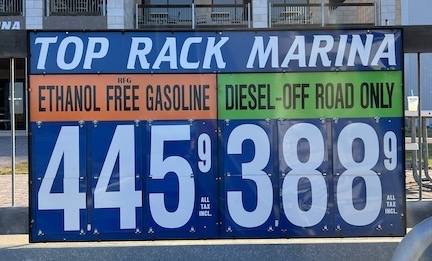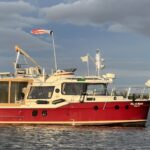Some pretty straightforward ways to make cruising — either on or off the Great Loop — more affordable.
One of the challenges some of us face as we cruise in the United States — especially in inflationary times — is keeping costs down. Unless your budget has no limit, you’re likely interested in finding ways to save money here and there along the way — even if it’s just so you’ve got more funds to do fun stuff.
Here are some of the things I’ve been doing to keep my costs down.
Anchor out more.

You can save a lot of money by anchoring out instead of parking at marinas.
If your boat is properly set up for anchoring out, spending more nights on the hook is probably the best way to save money. We all know what the average marina costs. Compare that to the cost of overnighting at an anchorage: free. But, as you may already know, the best part of anchoring out might be enjoying the peace and quiet of a natural area without marina noise and bright lights. The cost savings is just a bonus.
Consider price when choosing a marina.
You probably already do this — I know I do. I look at the whole picture, including Waterway Guide reviews, in an effort to get the most services I need for my money. Even just 50¢ per foot per night really adds up on a three-night stay in a 40-foot boat. And beware of marinas with hidden costs like “convenience fees” for using a credit card and resort fees that will apply even if you opt not to use the pool or restaurants.
Don’t pay extra for shore power.
Some marinas, especially in the southeastern states, charge an additional fee for power. The fee can be considerable — $20 or more per night – depending on your boat’s power cable connection. If your boat is set up for anchoring out, it probably also doesn’t need shore power for a short marina stay, especially if you don’t plan on running high power consumption appliances. I’ve routinely skipped the shore power hookup at costly ICW marinas and it has zero impact on my stay — other than to save me money and make it quicker for me to cast off when I’m ready to go. You know your boat and its power needs. Don’t pay extra for power if you don’t need to. Just be aware that most marinas won’t allow you to run a generator in your slip.
Take advantage of free (or lower cost) services when available.
If a marina offers free pump-out or free laundry facilities, why not take care of these chores while staying with them? You don’t need to wait until your waste tanks or laundry bags are completely full to empty them. The same goes for a marina with a courtesy car – isn’t that the perfect place to make a provisioning run? Even if you only need a handful of items or some heavy (to carry) beverages? (And please folks, if they give you a courtesy car, return it on time and add fuel any time there’s less than half a tank.)
Plan your fuel stops based on fuel prices.

It was worth cruising 5 miles out of my way to get diesel at a price like this when other marinas were charging more than $5/gallon. I had just 20 gallons in my 145 gallon tank when I arrived.
If you just get fuel when you need it and don’t pay much attention to fuel prices, you’re missing out on a great way to save money. Look at it this way: if you can save $1 per gallon on a 100-gallon purchase, that’s $100. Those savings add up. Fortunately, Waterway Guide makes it easy to find good fuel stops with Fuel Price Report. I view the list of marinas and prices for my area in mile marker order so it’s easy to see what’s coming up next and how far away it is. Then I plan my fuel stops — and sometimes choose marinas for overnight stops — accordingly. I’ll also top off my tank any time I’m at a marina with lower-cost fuel, even if I only have room for 30 or 50 gallons. The more lower cost fuel I can buy, the less higher cost fuel I have to buy. And remember, when evaluating fuel prices, to add in taxes or “convenience fees” when computing the total price. 7% tax and 3% convenience fee means the price you pay is 10% more than what’s published.
Cruise at a fuel efficient speed.
I’m sure most experienced boaters know this, but different speeds have different fuel efficiencies. Cruising at 6 knots, for example, is likely to burn less fuel per mile (and certainly per hour) than cruising at 10 knots. While no one wants to cruise at forward idle speed, no matter how much money it saves on fuel, you should be able to pick a speed that’s a good compromise for you. If your boat has an engine computer or chartplotter that’ll do the math for you, pay close attention to fuel economy at different speeds so you get a feel for how your boat burns fuel. What you learn may surprise you. For example, my Ranger Tug with its semi-displacement hull gets decent economy (nautical miles per gallon) at speeds up to 8 knots before economy deteriorates. But it gets the same decent economy at 14 knots as 8 knots — probably because the hull is as close to planing as it can be. So those are the two speeds I use: 6-8 knots for a lazy day of cruising on the ICW and 14-15 knots for crossing a long, boring body of water like the Gulf of Mexico or some large bays.
Take advantage of member discounts.
Boat US membership often entitles you to fuel or marina discounts. Remember the organizations you’re a member of and don’t forget to ask about discounts. Use discounts enough and the money you save may cover the cost of the membership.
Eat out less — or eat dinner out less.

There’s nothing quite like a plate of seared scallops on a bed of fresh spinach and risotto, but I could have made this in my boat for a fraction of the $42 price tag.
Dining out can be a huge expense these days, especially for dinner. You can make a good steak dinner on board your boat for a fraction of what it costs to eat that steak dinner in a restaurant. I’ve gotten into the habit of having a big lunch in a restaurant or café when I’m exploring a destination instead of going out for a (usually) more pricey dinner. Leftovers re-heated in the microwave make a great lunch when I’m on the go. And those fancy cocktails are a lot less expensive when enjoyed as docktails you make with other cruisers.
Uber less.
We all know how convenient Uber, Lyft, and good, old-fashioned taxis can be to get to a destination from a marina, but there may be less expensive options. Look for free or low-cost shuttle buses or even regular local buses. Do you have bicycles on board? Whether they rely on pedal power or have an electric motor, they can get you to a lot of the places you might use a taxi service to reach. And don’t forget about walking; after hours sitting in a seat, cruising to a destination, it’s good to get out and stretch your legs. We all need the exercise! If you need to make a provisioning run, consider walking to the market and Ubering back with your purchases. At least you’ll save half the fare.
Your Ideas?
These are the things I’m doing to keep my costs down as I cruise on the Great Loop in my Ranger Tug. I bet you could do some of these things, too.
And maybe you have a few tips you want to share with other readers? Comment on this post to let us know.




Very practical and easy to save ideas. It also doesn’t cut down much on the “fun factor” , especially if you don’t mind being on the boat or using the dingy for trips from an anchorage to shore.
While it may be a bit harder to socialize, (particularly if solo) at anchor, it is still doable by dingy to other boats in the anchorage or to shore spots.
Thanks very much. I have to say that I’ve started really preferring good anchorages. And yes, you can dinghy to visit Looper friends at anchor. That’s what makes Nebo so handy; you can see where your friends are and meet up with them, even if you’re not at a marina.
Many of these tips also apply to RVing. We just finished our first dry camping experience, and now I’m hungry for more.
Dry camping and anchoring out are the same thing, but one’s in an RV and the other is in a boat. In Washington state, look for national forest roads. You can pretty much camp anywhere that you’re not blocking the road with your rig. There are a ton of great spots on the east end of Cascade Highway (think Mazama and north of there) or around Mt Rainier, outside the national park. Remember, most of these roads are unpaved so your tow vehicle needs to be suitable for gravel and possibly some ruts. I could tell you about some amazing spots down in Arizona.
Hello Maria,
I don’t believe we met on the loop but we have mutual friends who say great things about you. This was a great article and money saving advice.
Here are a few things we did on the loop to save money and make our journey more enjoyable. Consider joining a social club before leaving home, such as Moose lodges, Elk Club, VFW or American Legion. Most of these have social rooms with dramatically reduces food and drink along with the added bonus of meeting like minded locals who are usually thrilled to learn more about you and the loop.
We also volunteered for several not for profit organizations throughout the loop. It was of course a way to give back to the local community that welcomed us to their city and again allowing us to meet like minded individuals. At many of these events, volunteers are treated like gold! We received free T shirts, we attended volunteer pre or post event parties, usually with food and drinks, as well as free tickets to the event it self. These were just some of the perks we enjoyed. If you ever paid for two weeks worth of tickets to a music festival in Key West you understand the “value” of volunteering for a few shifts in return for complimentary weekly wristbands.
These are great suggestions! Thanks so much for sharing them.
And now you’ve got me curious about who those mutual friends are.🤔